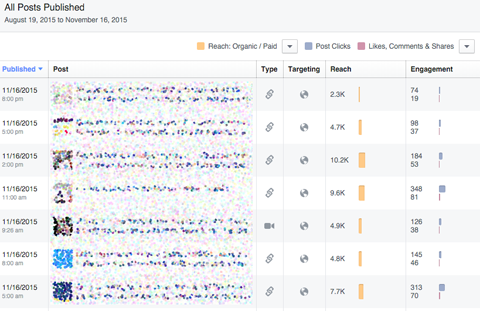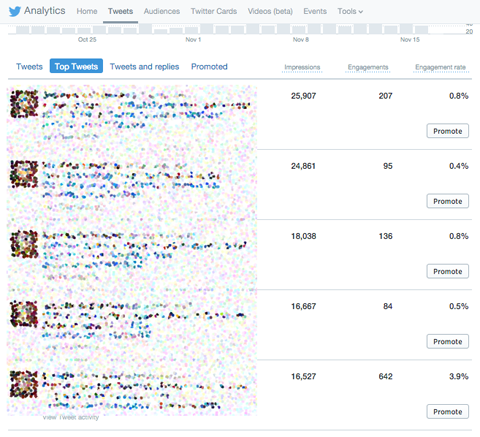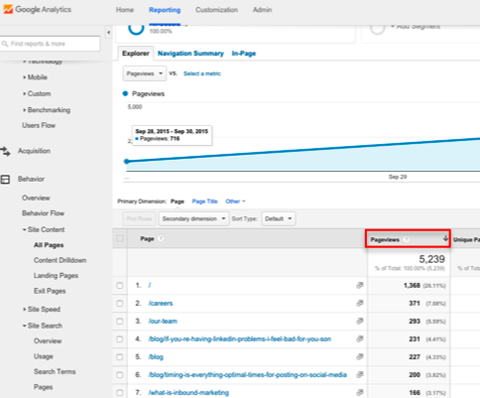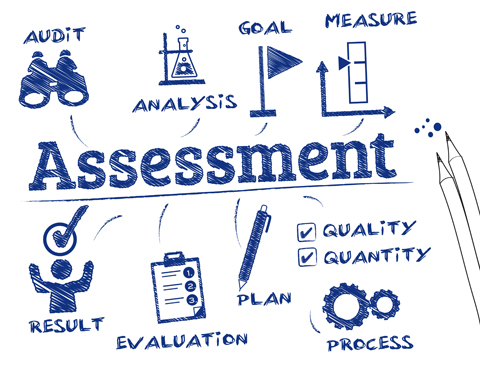Is social media working for you?
Want better results?
Regularly analyzing the performance of your social media marketing helps ensure your content and profiles are delivering.
In this article you’ll discover four monthly assessments to improve your social media marketing results.

Discover how to improve your social media marketing with monthly assessments.
#1: Review Key Performance Indicators
Most marketers will tell you that if you didn’t measure it, it didn’t happen. Before you go running to your dashboard, though, it’s important to know what you need to measure.Determine which key performance indicators (KPIs) actually matter to your business.
B2Cs, for example, often care about engagement and brand awareness. This means metrics such as likes, shares, comments, followers and retweets. B2Bs, on the other hand, put more weight on the clicks, conversions and website traffic coming from social channels.

Determine the key metrics for your business. Image: Shutterstock.
Look at the numbers to see where your leads are coming from, when and how they convert and what types of content produce the greatest returns. From there, you can determine what to tweak for the best possible performance, and what to discard or modify.
You can (and should) consider both quantitative and qualitative metrics. Quantitative factors are more concrete and easier to measure (optimal time of day and character count). Qualitative factors are more abstract (subject matter and tone of voice) and can be a bit trickier to measure accurately.
Quantitative Metrics
Once you’ve selected your KPIs, start with the quantitative analysis.
Pay attention to the best times to post your social content. Many social media tools automatically analyze this for you, but you can also check manually.
For example, look at the top-performing posts based on clicks (assuming that posts with fewer than five clicks shouldn’t be counted), and see if you can identify a pattern in terms of days and hours. Also look at your worst–performing posts and compare their times and days to the successful set.
Find out if your audience prefers shorter, snackable messaging or longer, meatier posts.Look at the character count for Twitter or the word count for LinkedIn and Facebook to see which lengths were most successful for each network.

Review your social analytics to find useful data.
Although 65% of B2B marketers realize that visual content works, look at whether visual posts are really driving engagement for your brand. Also, find out what kind of visuals worked best: images, videos, slides, infographics or GIFs. For Twitter, despite research showing that tweets with images generally outperform those without, that may or may not be true for your business.
Depending on which social networks you’re posting to, check the impact of hashtags and keywords you‘ve used. If you see that a certain hashtag isn’t getting you results, turn toHashtagify.me or RiteTag to find new ideas, especially more long-tail versions that your target audience may be monitoring.
Qualitative Metrics
There are also some qualitative metrics you need to review monthly:
Identify what topics have performed well. Is there an increasing number of shares, likes and inquisitive comments when you promote blog posts about certain topics, events or trends? The easiest way to assess this is to bucket all of your social posts into“campaigns” when writing them. Then you can see which campaign did the best, anduse this knowledge to write similar content.
Assess whether your top posts were written in an educational, humorous or straightforward tone. This one is a bit harder to analyze. Try to find out if people are reading your posts to educate themselves professionally or reading them just for fun.
Keep in mind that while B2C marketing efforts focus on driving traffic and engagement (which are, no doubt, important to any marketing effort), B2B campaigns are focused on leads. Ultimately, you’ll use your analytics to help find out how many of the people you‘re engaging through social channels will contribute to your bottom line.
After you’ve identified and dissected your top-performing posts, the next step is to republish them.
#2: Discover Top Social Posts for Republishing
We all know that Twitter reach, similar to many other social networks, is far from 100%, and the average life of a social post is fleeting. This is all the more reason to save time and resources by rescheduling your best social content.
Before you repost social content, keep a few points in mind. First, don‘t republish time-sensitive content. Stick to evergreen collateral that‘s always relevant and can breathe new life into your marketing campaigns for months to come.
Also, focus on republishing original work featured on your website and not curated content (unless it’s a guest post from your brand). As valuable as curated content is, it’s often more time-sensitive and drives traffic to external sites.
With those guidelines in place, turn your attention to the business of actually republishing your proven social messages. Here’s a simple two-step plan to help you get that done:
Identify your top 20 tweets from last month. As mentioned above, top tweets can be defined based on the number of clicks, retweets, favorites or any other KPI. If you don’t have 20 tweets that performed well, use the top 10.

Reschedule top posts across your social channels.
Then, republish your top tweets across all related Twitter accounts. Take each of those tweets, and schedule them across all of the personal and company handles multiple times for the coming month. Also, spread them out to reach different time zones.
You can take a similar approach with Facebook or LinkedIn posts. However, since these posts have a longer shelf life, don‘t republish them more than once or twice per month on your company pages. Also post to different groups than you originally did.
Republishing your content is essential to moving your social engagement strategy forward, and will save you time and money in the long run.
#3: Identify the Best Content for Repurposing
Take the same thought process you’ve applied towards reposting your top social posts, and apply it to repurposing all of your best-performing content assets.
Which kinds of successful content can you repurpose on social? Consider blog posts, videos, webinars, white papers, templates, infographics and more.
When choosing what content to repurpose, focus on what has performed well in the past month. If you try to evaluate all of the content you’ve ever produced, you’ll end up promoting the same high-performing content month after month and miss out on opportunities to grow your more recent content’s reach.
Before creating a repurposed content campaign, refer to item 1 of this post, and make a list of the optimal days and times to publish, along with character count and profiles. Then use Google Analytics to give you a broad overview of the content types that are generating the most traffic, conversions and ROI.

Use Google Analytics to find your best-performing content.
Combine this information to determine what content would lend itself successfully to other consumable forms.
#4: Evaluate Social Profiles for Effectiveness
If your company is looking to grow and gain an expanding foothold in the marketplace, your social profiles need to adapt over time.
Evaluate whether your existing profiles are working. If your LinkedIn profile is getting lots of engagement, and your Twitter presence is an active conversation hub, you might not need to do much. But if any of your social accounts are starting to falter, it’s a clue that your social campaigns might benefit from updating the fledgling profiles or networks, or removing them altogether.
For example, if Facebook simply isn’t working for you, consider dropping it. It’s a fine social network and the cornerstone of B2C social marketing success, but B2B companies are increasingly finding that the channel may not be worth their lead generation efforts.

Assess each of your profiles monthly. Image: Shutterstock.
Copyblogger’s post on quitting the network gives marketers some food for thought. If B2B leads are neither generated nor engaged through a platform, then despite its popularity, it’s best to leave that platform alone.
If you’re using individual social profiles, chances are you’re posting to groups or communities through them. The popularity of certain groups often changes, so every month it’s crucial to remove the ones that aren’t working anymore. Also, put aside some time to research any new groups that might warrant your membership.
Conclusion
In the social media world, there’s no question that each day counts, but what happens at the end of the month? Take the time to analyze your social media results and how you can improve on them.
What do you think? How do you ensure your social outreach is running smoothly? Do you track the performance of your social efforts each month? What key areas do you focus on? Please share your thoughts in the comments below.
KPI photo and Assessment photo from Shutterstock.
To view the original article Click Here

No comments:
Post a Comment